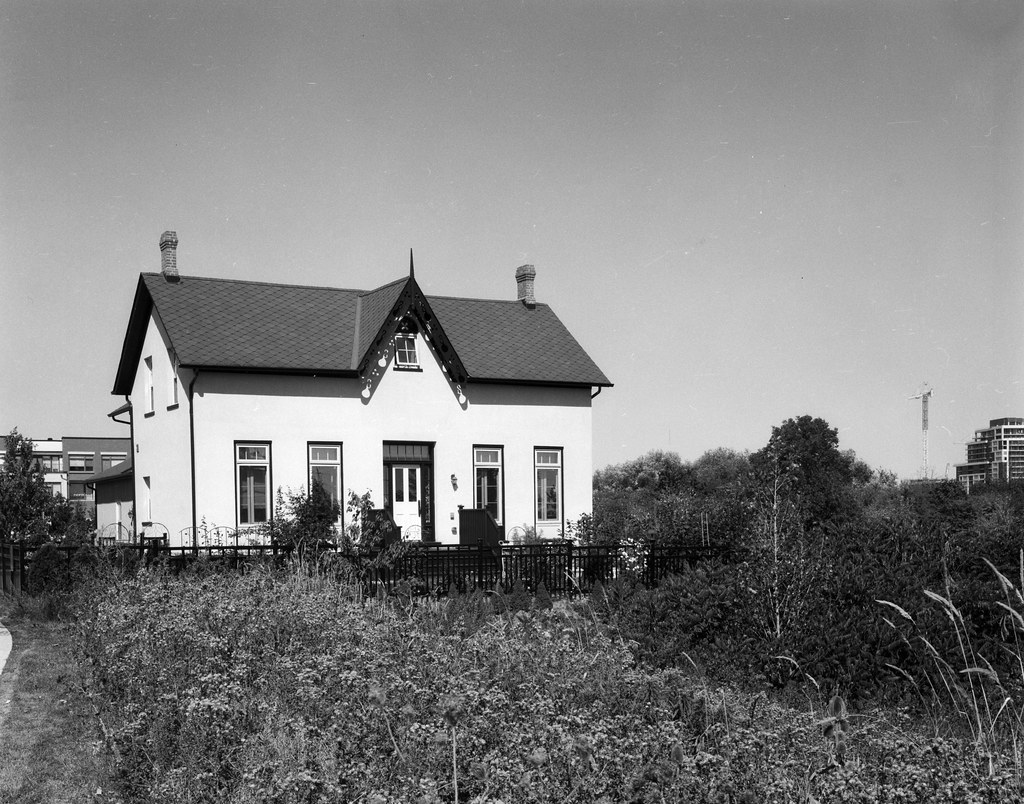Postville is among the lost villages of the Trafalgar Township, with only a few things left around that remind people that a small but thriving village once stood at the modern intersection of Trafalgar Road and Dundas Street. And Postville is the village I did not intend to write about, thinking this small farmhouse was part of Munn’s Corner; thank goodness for plaques.

Graflex Crown Graphic – Fuji Fujinon-W S 1:5.6/150 – Arista EDU.Ultra 400 @ ASA-200 – Ilford Ilfotec HC (1+47) 7:30 @ 20C
The Post family began purchasing properties around the intersection of 7th Side Road (Trafalgar) and Dundas Road between 1812 and 1816. Jordan, Ephriam, and Abigal. Abigal’s properties were inherited by her son Jordan Jr upon her death. The small community took the name Post’s Corner. While primarily a farming community, a small creek provided power for a mill, also an Inn and General Store for those stopping on the stagecoach route. The lines between Post’s Corner and Munn’s Corner were blurry as both were close to each other, and there was no actual boundary between the two, except for different side roads (Munn’s being centred around 6th Side Road). But the arrival of James Appelbe in 1840 changed the tiny hamlet’s trajectory. Appelbe quickly established himself as a leading citizen in the hamlet and the township as a whole. He purchased the general store and moved the post office from Munn to the newly renamed Postville, with himself as Postmaster. He created the Trafalgar Plank Road from 7th Side Road to improve travel to the growing community of Oakville and other settlements along the road. Soon a school, a steam-powered mill, and a company of Militia were established by the end of the 1850s, and Appelbe built a small house for himself and his wife in 1866. The tiny hamlet continued to thrive as a small farming community through the rest of the century and into the 20th century. Like the others, Postville was absorbed into Oakville in 1962, and the general store and inn were demolished in 1865 to make room for a service centre. Soon the rest of the community vanished as Oakville expanded north. The former Appelbe house, having survived decades of neglect, was restored in 2016 during major urban construction in the areas of Munn and Postville. And while much of the community is under pavement and big box stores, the Appelbe house, several abandoned houses and Postville Street are reminders of the small community that once thrived at Oakville’s northern edge.
I had seen this house many times before and wondered about its history. And, like anything, I wanted to get a photograph of it before it was either torn down or made impossible to photograph. Honestly, believing it was part of the former hamlet of Munn’s Corner. Thankfully the efforts of the restoration team installed a plaque that told me of Postville. I set up my camera by a shelter overlooking a stormwater control pond to see the front of the Appelbe house. I originally went with my 210mm lens, then to the 180mm before settling with the 150mm to provide context to the modern setting, but still giving some front rise to get plants out of the bottom of the frame. Metering proved interesting with the high overhead light, but I came up with exposure using the roof and the front of the house to average things out. I honestly should have under-exposed a stop to help bring back the highlight details on the main body of the house.